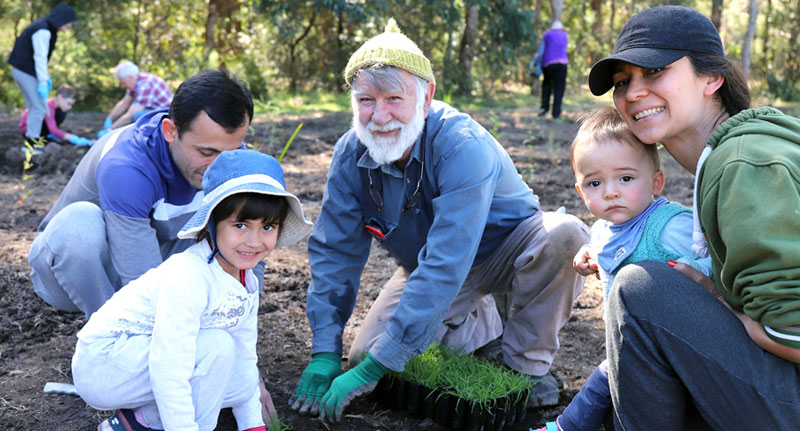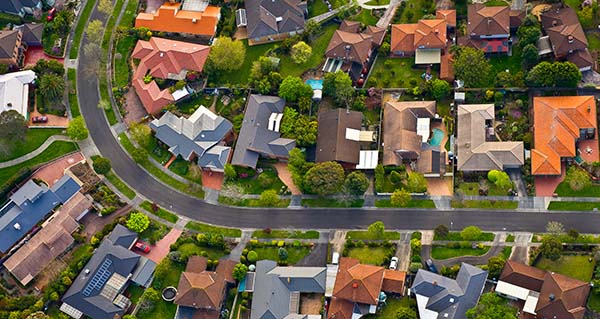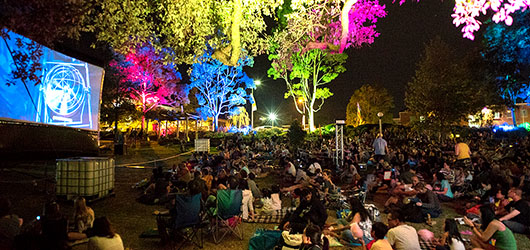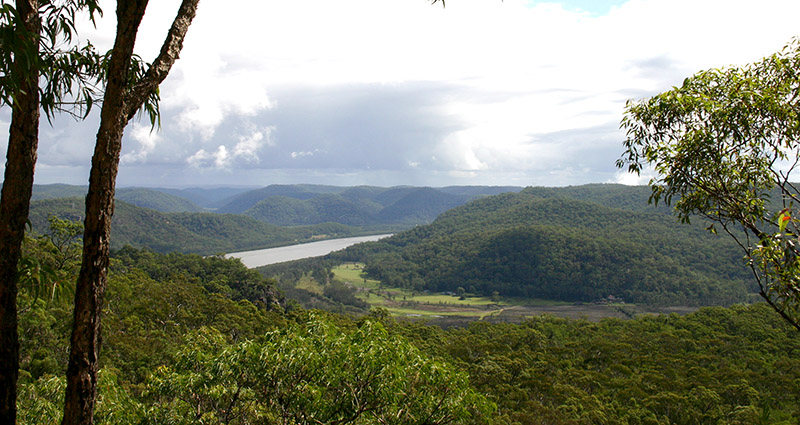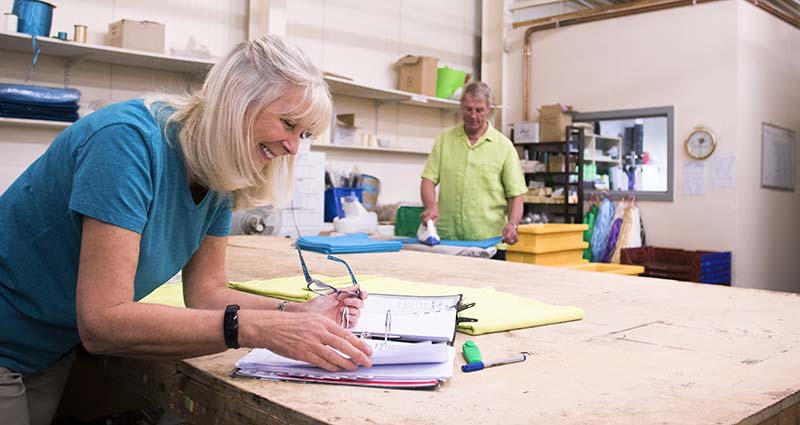Hornsby Council and members of the community are working to save the forest, but we need everyone’s help
What is Council doing in parks and reserves to protect Sydney Turpentine-Ironbark Forest?
Guided by Council’s Biodiversity Conservation Strategy, Council has specialised staff and contractors who work to protect and repair bushland in parks and reserves and in selected unmade road reserves. Bush regeneration contractors restore bushland at around 80 sites across the Shire, including eight (8) Sydney Turpentine-Ironbark Forest sites. Bushcare volunteers work at 65 sites across the Shire, guided by specialist site supervisors employed by Council. Eight (8) of these Bushcare groups work at Sydney Turpentine-Ironbark Forest sites. Volunteers from the Still Creek Landcare Group assist rural private property owners to look after the patches of Sydney Turpentine-Ironbark Forest growing on their land.
Entrusted with looking after a precious forest teetering on the edge of extinction, Council must carefully assess and plan any work and activities that could damage Sydney Turpentine-Ironbark Forest in parks and reserves. With the aim being the forest’s long-term survival, Council conducts and supports plant and animal surveys to measure the forest’s health and to keep an eye on its wildlife and other dependents. A sound understanding of each patch of Sydney Turpentine-Ironbark Forest and its place in the Shire’s wider bushland network is essential. From an environmental impact perspective, the location and design of any proposed tracks and trails, shared pathways, play spaces and stormwater drainage devices (to name just a few) can be guided by survey findings. Options can be considered, and decisions made to ensure protection of critically endangered forests into the future is given the highest priority.
Council warmly invites the community to visit the parks and reserves where Sydney Turpentine-Ironbark Forest grows. To experience its unique and striking beauty and to appreciate and understand the ways of nature, a visit to the forest is a must. Critical to the survival of the forest are human interactions that support its health and ongoing sustainability. As for precious works of art like Leonardo da Vinci’s Mona Lisa or Michelangelo’s David, access to and through Sydney Turpentine-Ironbark Forest must be appropriate and carefully managed.
What can I do to help protect Sydney Turpentine-Ironbark Forest?
- Spend some time in a Sydney Turpentine-Ironbark Forest:
- Take a wander along the mobility-assisted boardwalk through Carrs Bush in Fagan Park, Galston. A delightful discovery experience, you can learn more about the forest and the area’s history through sculptures and interpretive signs. Why not combine it with a picnic in the park!
- Bathe in the greenery beneath the canopy of Turpentine trees as you walk the tracks in and around Reddy Park, Hornsby
- Grab a coffee at nearby shops and head to Cherrybrook’s Appletree Park or Jane Starkey Park in Dawson Ave Thornleigh, where you will also find play spaces for the kids
- Stop and catch your breath while you admire the precious little patch of Sydney Turpentine-Ironbark Forest beside the sealed exercise path around Greenway Park, Cherrybrook.
- Simply enjoy the respite of being in nature
- Take up the offer of free plants from Warada Ngurang Community Nursery, where volunteers and staff propagate the plants, both big and small, that grow in a Sydney Turpentine-Ironbark Forest. Pop them in your garden and you will be helping creatures such as moths, butterflies and native bees that feed on and help pollinate the forest’s plants. You will also be helping wildlife such as the rare Glossy Black Cockatoo, who depends on a handful of trees for its food, including the Forest Oak (Allocasuarina torulosa), a small tree that grows in Sydney Turpentine-Ironbark Forest
- Participate in a guided bushwalk or event. Council’s free Guided Bushwalks Program caters for all, with walks for beginner bushwalkers and those with limited fitness, right through to challenging half-day bushwalks for those with experience and good fitness. Kids bushwalks and nature events are also provided. Not to forget our furry four-legged friends, Council also runs guided bushwalks for well-socialised dogs and their human companions. Look out for the walks that mention Sydney Turpentine-Ironbark Forest.
- Come along to a community planting event. Bring along your friends and family and experience the satisfaction of doing your bit to help the forest. There will be two community planting events held in or near Sydney Turpentine-Ironbark Forest per year, so keep your eye out for them on Council’s Events webpage.
- Remove weeds from your garden, as they can spread from near and far into Sydney Turpentine-Ironbark Forest. With most originating overseas, these weeds often have fewer natural predators here in Australia than do home-grown Sydney Turpentine-Ironbark Forest plants. This means they often out-compete native plants with their vigorous growth and can severely damage the forest’s health. Find out if you have any weeds of bushland growing in your garden, and if so, how to remove them.
- Keep your pets under control and never let them wander into any bushland areas, including Wildlife Protection Areas and national parks. Bushland is the home of wildlife. While some native animals, such as the Brush-tailed Possum, are relatively common and are often seen and heard, others are shy and secretive and may be uncommon or rare. Frogs and toads, reptiles, birds and mammals can be irresistible to cats and dogs. This is a very good reason to always walk your dog on a lead in Council’s parks and reserves (except for off-leash dog parks) and why cats should be prevented from entering bushland.
- Join a Bushcare group. Becoming a Bushcare volunteer is an enjoyable way to learn about Sydney Turpentine-Ironbark Forest with like-minded people. There are 8 Sydney Turpentine-Ironbark Forest Bushcare groups working once a month, each guided by a specialist site supervisor employed by Council. Volunteers learn about the forest and its wildlife simply by being there and lending a hand. They help the forest by removing weeds, protecting and creating habitat for wildlife, and planting where needed to supplement natural regeneration. There are groups who work in Sydney Turpentine-Ironbark Forest on a weekday and others that work on a Saturday or Sunday. Some groups work in the morning while others work in the afternoon, and there is sure to be a time and location to suit.
- Expand your knowledge about Sydney Turpentine-Ironbark Forest and how you can help to reduce threats. You can do this by visiting the links within these webpages.
- Report to Council any activities you suspect might be damaging Sydney Turpentine-Ironbark Forest.
- Have your say on plans and policies that may affect the management of Sydney Turpentine-Ironbark Forest, including plans of management, major projects, landscape concept plans, and masterplans for parks and reserves. Find out about Council’s current and upcoming infrastructure and works projects, including any located in or near Sydney Turpentine-Ironbark Forest.

